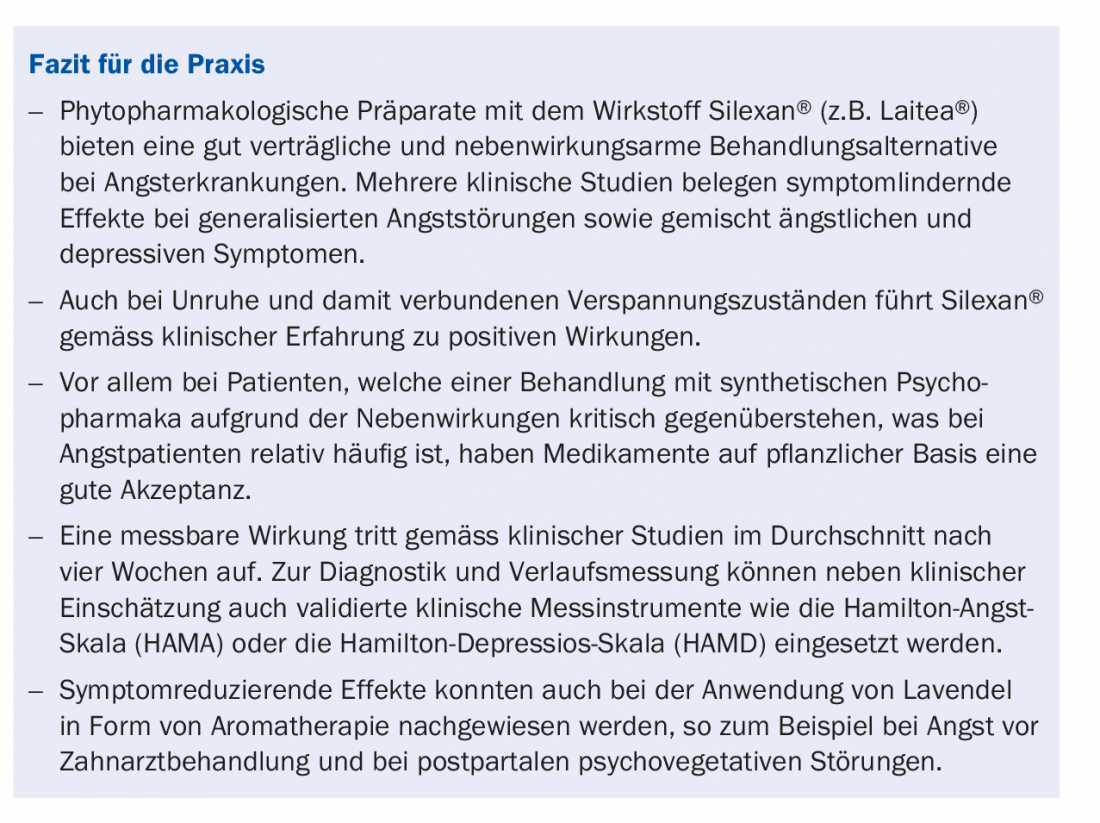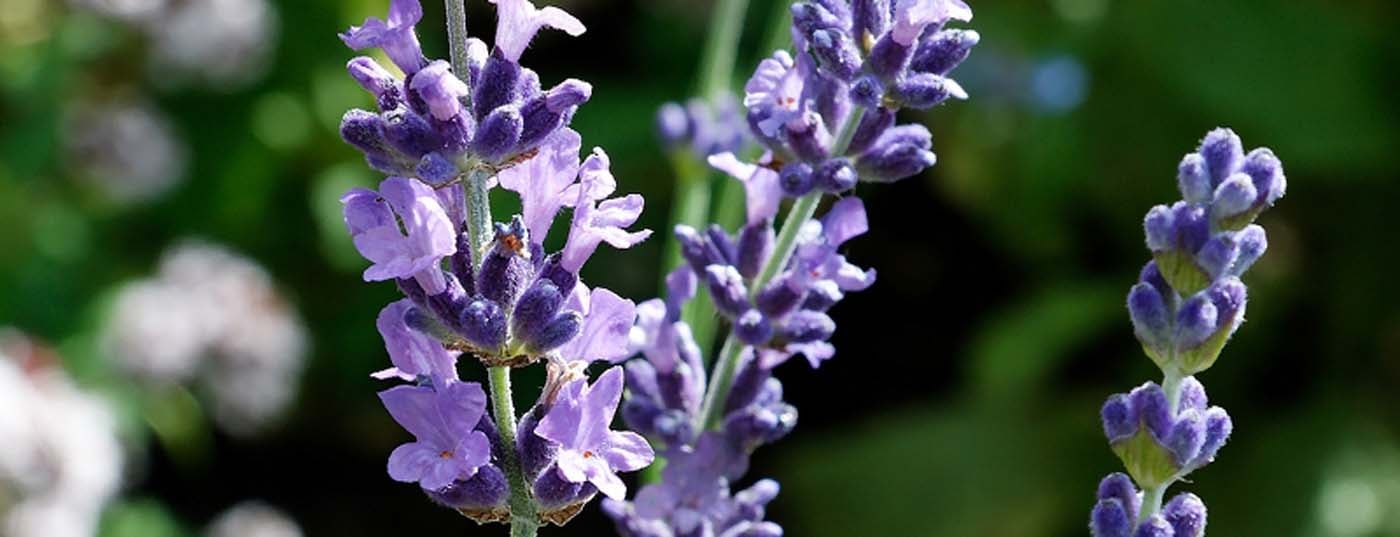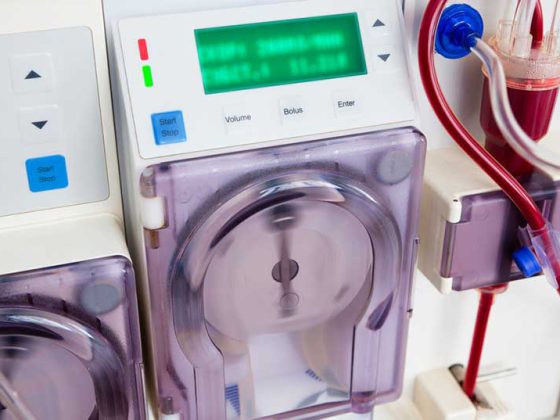Phytopharmacological preparations with the active ingredient Silexan® offer a well-tolerated treatment alternative with few side effects for anxiety disorders. Several clinical studies demonstrate anxiolytic effects in various forms of anxiety disorders as well as good compliance.
Already for several thousand years lavender has been used medicinally thanks to its antiseptic and relaxing effect. More recently, the positive effects of oral phytotherapeutics containing lavender oil on stress, anxiety, and depression have been clinically demonstrated in several studies [1–3]. In contrast to the standard synthetic psychotropic drugs prescribed for anxiety disorders, anxiolytic preparations based on lavender oil have few side effects and are well tolerated by anxiety patients. Benzodiazepines as well as pregabalin and antidepressants are highly potent drugs but have an unfavorable side effect profile. Benzodiazepines in particular, he said, are very effective for acute treatment but often lead to dependence problems with prolonged use. Synthetic pharmaceuticals are often rejected by anxiety patients in particular because of the side effects, explains Christian Imboden, MD, medical director and chairman of the clinic management of the Wyss Private Clinic in Münchenbuchsee.
Thus, there is a need for effective and well-tolerated treatment alternatives. An increasing number of study findings confirm the efficacy of lavender oil extracts in anxiety disorders and these are preparations which are associated with high therapeutic adherence. Furthermore, there are also study findings on positive effects of lavender in the context of aromatherapy, e.g. in relation to anxiety reduction before dental treatment [4] or postpartum [5].
Anxiety disorders in general medical care
With a prevalence rate of 14%, anxiety disorders are among the most common psychiatric disorders in Europe [6] and the second most common brain disorders after headaches [7]. Generalized anxiety disorders and panic disorders belong to the phobic group and are associated with somatic symptoms, which are often the reason for a consultation in a general medical practice.
According to an international epidemiological study published in 2016, the lifetime prevalence for a single panic attack is 13.2% and for panic disorder 12.8% [8]. Panic disorder is the repeated occurrence of panic attacks (seizure-like anxiety reaction) with sudden onset, no apparent reason, and lasting at least a few minutes. Typical panic symptoms on a physiological level are sweating, trembling, palpitations, heart palpitations as well as other vegetative complaints [9].
The prevalence of generalized anxiety disorder (GAS) in developed countries is 5% [10] according to an epidemiological study published in 2017, and the lifetime prevalence rate ranges from 3.7% [10,11] to 5% [12] depending on the data source. The leading symptom of GAS is excessive apprehension and constant worry [9]. In addition, physiological features such as restlessness, sleep disturbances, muscle tension, digestive disorders, etc., occur due to activation of the sympathetic nervous system. Developing comorbid depression is also common in the setting of GAS, Dr. Imboden said.
If an anxiety disorder is suspected, the Hamilton Anxiety Scale (HAMA) [13,14] can be used. This is a third-party assessment procedure that uses 14 items to assess the type, intensity, and severity of anxiety symptoms. If one suspects additional depressive symptoms, the Hamilton Depression Scale (HAMD) can be used [15,16]. HAMD is a third-party assessment scale consisting of 21 items with scores ranging from one to three [15,16]. Subsyndromal symptoms of anxiety and depression mixed are listed as a separate diagnosis in the ICD classification [9]. It is a disorder in which moderate to severe anxious and depressed mood are present but do not meet the criteria for a stand-alone individual diagnosis.
Mechanism of action of the lavender oil prepate Silexan®.
Silexan® is a lavender oil extract obtained by steam distillation from the medicinal lavender Lavandula angustifolia and contains a particularly high proportion of pharmacologically active esters (linalool as well as linayl acetate). Laitea® [17] is a phyotopharmacological silexan preparation in capsule form.
The main mechanism of action is the reduction of voltage gated calcium channel (VOCC) activity in the central nervous system [19]. By regulating the presynaptic calcium influx – which in excess leads to overexcitation of the neuron with effects on anxiety and sleep disorders – the overstimulated neuron can be brought back into balance [20]. The mechanism of action of inhibition of VOCCs is similar to that of the anxiolytic pregabalin, but unlike the latter, Silexan® binds non-selectively to VOCCs [20]. Pregabalin binds very selectively to a specific subunit of VOCCs, the speaker explained.
Another biochemical mechanism of action involves serotonergic neurotransmitter regulatory circuits. Continuous intake of Silexan® leads to a reduced binding capacity at presynaptic serotonin 1-A receptors, which play an important role in emotion regulation processes [21]. This effect on the serotonergic system is similar to the reduction in 5-HT (5-hydroxytryptamine)-1A binding capacity induced by SSRIs (selective serotonin reuptake inhibitors).
Clinical studies on efficacy in anxiety disorders
In a randomized, double-blind study over a ten-week period (n=539) [2], Silexan® was compared with the SSRI paroxetine in patients with generalized anxiety disorder (GAD). Scores in the primary endpoint (anxiety level measured with the Hamilton Anxiety Scale = HAMA) were lower in the Silexan®- and in the paroxetine condition significantly decreased compared to placebo (p<0.01), with Silexan® being non-inferior to the paroxetine 20 mg (n=132) condition at both 80 mg (n=135) and 160 mg (n=121) doses. Effect sizes of 0.37 (80 mg dosage) and 0.50 (160 mg dosage) are comparable to effect sizes of SSRIs for anxiety disorders [22]. Also, regarding depressive symptoms, both the paroxetine and silexan conditions showed a significant reduction in the corresponding scores (HAMD) compared to placebo. The anxiety- and depression-reducing effects of Silexan® were significant from the fourth week.
In another study, Silexan® 80 mg was also found to be non-inferior to the benzodiazepine lorazepam (Temesta®, 0.5 mg) in a sample of patients with GAD [23]. Temesta® has a rapid onset of strong anxiolytic effects, but often leads to dependence, the speaker explained. Temesta® 0.5 mg is a rather low dosage, but it is not so rare in household practice. The study period of this controlled clinical trial was six weeks and the primary endpoint was anxiety reduction (HAMA) at six weeks compared to baseline. In the Silexan® condition, a mean reduction in HAMA scores of 45% was achieved; in the lorazepam condition, this value was 46%.
In a sample of patients with mixed anxiety and depression [9], a ten-week double-blind randomized trial (n=318) also demonstrated a significant reduction in both anxiety symptoms (HAMA; p<0.01) and depressive symptoms (MADRS; p<0.001) from Silexan® 80 mg (n=159) compared to placebo (n=156) [24]. Symptom reduction by Silexan® was observed from the fourth week. Sleep quality parameters were also collected in this study using the Pittsburgh Sleep Quality Index (PSQI). Sleep disorders and anxiety disorders often occur comorbidly, which can be explained by dysregulation of the autonomic system, among other factors [25]. Silexan® also resulted in a significant improvement in sleep quality compared to placebo, with the delayed onset of action (from week six) compared to anxiety reduction (from week four) suggesting that sleep disturbance relief is moderated via an anxiolytic mechanism [26], which is also consistent with the conclusion of a meta-analysis published in 2017 [27].
The use of lavender extracts in aromatherapy has also been shown to have positive effects. In a randomized-controlled clinical trial (n=140) over a four-week period, lavender aromatherapy produced a significant reduction in postpartum psychovegetative symptoms. All primary endpoints (stress, anxiety, depression) showed significantly decreased scores at four and twelve weeks postpartum (p<0.0001) [5]. Lavender aromatherapy also achieved positive effects in relation to fear of dental treatment. In an intervention study with adult dental patients (n=579), a reduction in anxiety was measured in the verum condition compared to the placebo condition [4], and this effect was significant in patients over 35 years of age. Anxiety levels were assessed using a rating scale in the waiting room [28].

Clinical use and tolerability of Silexan®
Silexan® is generally very well tolerated. Unlike pregabalin or benzodiazepines, Silexan® does not have a sedative effect and does not lead to dependence and withdrawal symptoms. Occasionally, mild epigastric discomfort occurs (belching, mild dyspeptic symptoms) [1], which can usually be avoided by correct intake, as Dr. med. Imboden pointed out.
An initial dosage of 80 mg is recommended, ideally with a meal and plenty of still water, to minimize the risk of gastrointestinal side effects. It is also advisable to instruct patients to avoid carbonated beverages for ingestion. Silexan® can be taken regardless of the time of day because it is not sedating. If necessary, the intake can also be spread over two intake times. If there is a partial response, it is recommended to increase the dosage to 160 mg, the speaker said. Laitea® is covered by health insurance.
No interaction effects should occur when combined with other drugs. Silexan® showed no relevant inhibitory or inducing effects on cytochrome P450 isoenzymes in a cocktail study [29]. The effect of oral anticonceptives is also not reduced by Silexan® [30].
Source: 33rd Swiss Annual Conference on Phytotherapy, November 22, 2018, Baden.
Literature:
- Kasper S: An orally administered lavandula oil preparation (Silexan) for anxiety disorder and related conditions: an evidence based review. Int J Psychiatry Clin Pract. 2013; 17 Suppl 1:15-22.
- Kasper S, et al: Lavender oil preparation Silexan is effective in generalized anxiety disorder – a randomized, double-blind comparison to placebo and paroxetine. The International Journal of Neuropsychopharmacology 2014; 17(6): 859-869.
- Kasper S, Anghelescu I, Dienel A: Efficacy of orally administered Silexan in patients with anxiety-related restlessness and disturbed sleep–A randomized, placebo-controlled trial. Eur Neuropsychopharmacol 2015; 25(11): 1960-1967.
- Zabirunnisa M, et al: Dental patient anxiety: Possible deal with Lavender fragrance. Journal of Research in Pharmacy Practice 2014; 3(3): 100-103.
- Kianpour M, Mansouri A, Mehrabi T, Asghari G: Effect of lavender scent inhalation on prevention of stress, anxiety and depression in the postpartum period. Iranian Journal of Nursing and Midwifery Research 2016; 21(2): 197-201.
- Wittchen HU, et al: The size and burden of mental disorders and other disorders of the brain in 2010. European Neuropsychopharmacology 2011; 21: 655-679.
- Maercker A, et al: Cost of Disorders of the Brain in Europe Study G. The costs of disorders of the brain in Switzerland: an update from the European Brain Council Study for 2010. Swiss Medical weekly 2013; 143:w13751.
- De Jonge P: Cross-national epidemiology of panic disorder and panic attacks in the world mental health surveys. Depress. Anxiety 2016; 33(12): 1155-1177. doi: 10.1002/da.22572.
- ICD-10-GM-2018 Classification. www.icd-code.de, last accessed 11/23/2018.
- Ruscio AM, et al: Cross-sectional Comparison of the Epidemiology of DSM-5 Generalized Anxiety Disorder Across the Globe. JAMA Psychiatry 2017; 74(5): 465-475.
- American Psychiatric Association: Diagnostic and Statistical Manual of Mental Disorders, 5th ed. (DSM-5). Washington, DC: American Psychiatric Association; 2013.
- Zanni GR: Anxiety Disorders: Real Disease, Real Treatment. PharmacyTimes 2014, March 14, www.pharmacytimes.com/publications/issue/2014/march2014/anxiety-disorders-real-disease-real-treatment, last accessed Nov. 23, 2018.
- Hamilton M: Hamilton Anxiety Scale (HAMA). In: Collegium Internationale Psychiatriae Scalarum (CIPS; ed.). International scales of psychiatry. 5th ed. Göttingen: Beltz Test 2005.
- Medicine-Knowledge-Online. Hamilton Anxiety Scale (HAMA). www.medizin-wissen-online.de/index.php/psychiatrie/165-testpsychologische-untersuchungen/psychologische-untersuchung-bei-angst-panikstoerungen/134385-hamilton-angstskala-hama, last accessed 11/23/2018.
- Hamilton M: The Hamilton rating scale for depression (HAMD). In: Sartorius N, Ban TA (eds). Assessment of depression. Berlin, Heidelberg, New York: Springer 1986; 143-152.
- DocMedicus Health Encyclopedia. Depression diagnosis. www.gesundheits-lexikon.com/Der-Gesundheitscheck-Check-up-Programme-bei-Ihrem-Arzt/Depressionstest, last accessed 11/23/2018.
- Arzneimittelkompendium der Schweiz: Patienteninformation Laitea®, https://compendium.ch/mpub/pnr/1354538/html/de, last accessed 23.11.2018.
- Arzneimittelkompendium der Schweiz: Patienteninformation, https://compendium.ch, last accessed 23.11.2018.
- Müller W, et al: Pharmacological basis of the therapeutic use of Silexan (Lasea®). Psychopharmacotherapy 2015; 22: 3-24.
- Schuwald AM, et al: Lavender oil – potent anxiolitic properties via modulating voltage-dependent calcium channels. PLoS ONE 2013; 8(4): doi: 10.1371/journal.pone.0059998.
- Baldinger P, et al: Effects of Silexan on the serotonin-1A receptor and microstructure of the human brain: a randomized, placebo-controlled, double-blind, cross-over study with molecular and structural neuroimaging. Int J Neuropsychopharmacol 2014; 18(4). doi: 10.1093/ijnp/pyu063.
- Hidalgo RB, Tupler LA, Davidson JR: An effect-size analysis of pharmacologic treatments for generalized anxiety disorder. J Psychopharmacol 2007; 21(8): 864-872.
- Woelk H, Schläfke S: A multi-center, double-blind, randomised study of the Lavender oil preparation Silexan in comparison to Lorazepam for generalized anxiety disorder. Phytomedicine 2010; 17(2): 94-99.
- Kasper S, et al: Efficacy of Silexan in mixed anxiety-depression – A randomized, placebo-controlled trial. Eur Neuropsychopharmacol 2016; 26(2): 331-340.
- Ohayon MM, Shapiro CM, Kennedy SH: Differentiating DSM-IV anxiety and depressive disorders in the general population: comorbidity and treatment consequences. Can J Psychiatry 2000; 45(2): 166-172.
- Kasper S, Anghelescu I, Dienel A: Efficacy of orally administered Silexan in patients with anxiety-related restlessness and disturbed sleep – A randomized, placebo-controlled trial. Eur Neuropsychopharmacol 2015; 25(11): 1960-1967.
- Möller HJ, et al: Efficacy of Silexan in subthreshold anxiety: meta-analysis of randomised, placebo-controlled trials. European Archives of Psychiatry and Clinical Neuroscience 2017; 1-11.
- Hosey MT: UK National Clinical Guidelines in Pediatric Dentistry. UK National Clinical Guidelines in Paediatric Dentistry. Managing anxious children: The use of conscious sedation in paediatric dentistry. Int J Paediatr Dent 2002; 12: 359-372.
- Doroshyenko O, et al: Drug cocktail interaction study on the effect of the orally administered lavender oil preparation silexan on cytochrome P450 enzymes in healthy volunteers. Drug Metab Dispos 2013; 41(5): 987-993. doi: 10.1124/dmd.112.050203. epub 2013 Feb 11.
- Heger-Mahn D, et al: No interacting influence of lavender oil preparation silexan on oral contraception using an ethinyl estradiol/levonorgestrel combination. Drugs in R&D 2014; 14(4): 265-272.
HAUSARZT PRAXIS 2018; 13(12): 30-32











